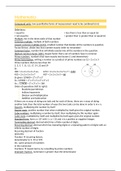Samenvatting
BMAT section 2 summary Mathematics 2021
Total summary of the 2021 mathematics specimen for section 2. In the summaries the subjects are clearly divided, important terms are underlined and it includes multiple examples, pictures and useful tables.
[Meer zien]




